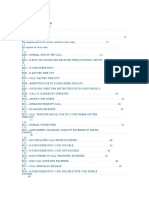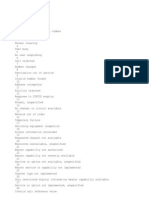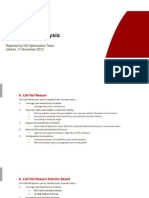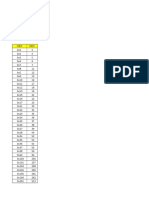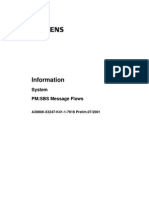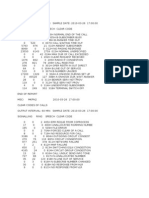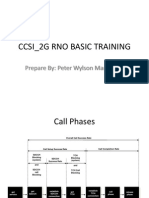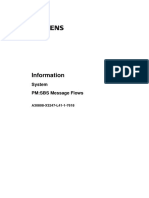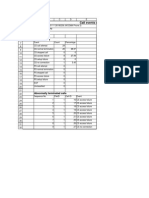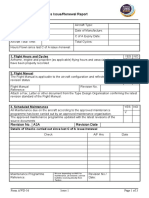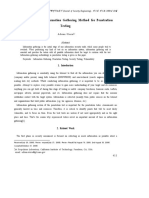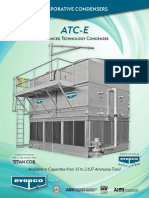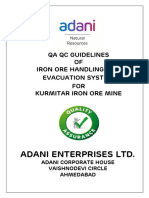CDMA Call Processing Failures
Uploaded by
Pratham SinghCDMA Call Processing Failures
Uploaded by
Pratham Singh***************************************************************************** Category Number: [E196-D020-C080-P010-O013-R001-M063/CDMA] A U T O P L E X(R) C T S / P M B U L L E T I N CDMA Call Processing Failure Message Descriptions **************************************************************************** CTS/PM BULLETIN #: 00-011
(Page 1 of 20) DATE: 04/05/2000 ____________________________________________________________________________ CRITERIA IMPACT -----CDMA CALL PROCESSING FAILURE MESSAGE DESCRIPTIONS INSTALLATION IMPACT ------------------No AFFECTED SYSTEMS ---------------5E-DCS, 850MHz CDMA, ECP, OMP, PCS CDMA, PCS Mini Cell, Series II Cell AFFECTED GENERICS ----------------All EXPIRATION CRITERIA -------------------03/29/2001 TECHNICAL INFORMATION ABSTRACT -------This document summarizes information obtained from multiple sources concerning Call Processing Failure (CPFAIL) Messages associated with AUTOPLEX(R) systems. This document is an update to the Customer Technical Support Bulletin #98-038 issued October 1998. A call processing failure message is generated either by the cell site or the Mobile Switching Center (MSC) complex when an abnormal event occurs during call processing. An analysis of these events may be useful in determining hardware, translations, Radio Frequency (RF), or other types of problems within the system. There are 3 categories of CDMA CPFAIL : (1) CE/CCC CPFAIL MESSAGES (initiated (2) RCC CPFAIL MESSAGES (initiated by (3) DCS CPFAIL MESSAGES (initiated by messages depending on where they are triggered by CDMA Hardware in the cell site), the central processors in the cell) and the 5E-DCS)
This document describes the failure messages, their probable causes, and the impact on end subscribers. The information is provided in two formats, first a table for quick look-up and then a verbose listing of the failures with additional information.
CTS/PM BULLETIN #: 00-011 (Page 2 of 20) DATE: 04/05/2000 ____________________________________________________________________________ DESCRIPTION ----------1.0 INTRODUCTION This document summarizes information obtained from multiple sources concerning Call Processing Failure (CPFAIL) Messages associated with AUTOPLEX(R) systems. This document is an update to the Customer Technical Support Bulletin #98-038 issued October 1998. A call processing failure message is generated either by the cell site or the Mobile Switching Center (MSC) complex when an abnormal event occurs during call processing. An analysis of these events may be useful in determining hardware, translations, Radio Frequency (RF), or other types of problems within the system. There are 3 categories of CDMA CPFAIL : (1) CE/CCC CPFAIL MESSAGES (initiated (2) RCC CPFAIL MESSAGES (initiated by (3) DCS CPFAIL MESSAGES (initiated by messages depending on where they are triggered by CDMA Hardware in the cell site), the central processors in the cell) and the 5E-DCS)
This document describes the failure messages, their probable causes, and the impact on end subscribers. The information is provided in two formats, first a table for quick look-up and then a verbose listing of the failures with additional information. Note that the majority of these failure events are not pegged in system service measurements, although most of them result in either a call setup failure of a dropped call from an end subscriber (i.e., mobile user) point of view. CDMA-7.x / ECP-12.x, and ongoing forward modifications and enhancements will include some or all of these service measurement peg counts. 2.0 SAMPLE OUTPUT MESSAGE ======================================== A 02 REPT:CELL 42 CP FAILURE, UNANSWERED ORIGINATION CDMA TRAFFIC CHANNEL CONFIRMATION FAILURE TRAFFIC CHANNEL FAILURE REASON - ACQUIRE MOBILE FAILURE [2] DCS 1 TG 997 TM 5 SG 0 ANT 2 FS-ECP ID 1 DN (917) 407-3689 SN Xb001e98c SCM a0 ALW CDMA, ASGN CDMA CCC 2, CCU 1, CE 5, ECP ID 1 07/20/98 00:02:03 #924549 ======================================== ======================================== A 40 REPT:CELL 30 CP FAILURE, ANSWERED ORIGINATION CALL SHUTDOWN CALL SHUTDOWN REASON - HANDOFF COMPLETE TIMEOUT [10] CALL RELEASE REASON - INTERNAL ERROR BY EITHER SIDE [1] DCS 1 TG 997 TM 169 SG 0 ANT 3 FS-ECP ID 1 DN (917) 653-5811 SN Xb0e14077 SCM b4 ALW CDMA, ASGN CDMA CCC 2, CCU 1, CE 1, ECP ID 1 CELL 50, CCC 2, CCU 2, CE 9, ANT 3, ECP ID 1 CELL 206, CCC 2, CCU 2, CE 0, ANT 1, ECP ID 1 07/20/98 00:40:29 #925290 ======================================== 2.01 SAMPLE OUTPUT MESSAGE FLEXENT MICROCELL ============================================== A 40 REPT:CELL 30 CP FAILURE, ANSWERED ORIGINATION CALL SHUTDOWN
CTS/PM BULLETIN #: 00-011 (Page 3 of 20) DATE: 04/05/2000 ____________________________________________________________________________ CALL SHUTDOWN REASON - HANDOFF CALL RELEASE REASON - INTERNAL DCS 1 TG 997 TM 169 SG 0 MICRO DN (917) 653-5811 SN Xb0e14077 ALW CDMA, ASGN CDMA MICRO 1, CCU 1, CE 1, ECP ID 1 COMPLETE TIMEOUT [10] ERROR BY EITHER SIDE [1] 1 FS-ECP ID 1 SCM b4
07/20/98 00:40:29 #925290 ======================================== 2.02 SAMPLE OUTPUT MESSAGE FLEXENT MODULAR CELL ================================================= A 40 REPT:CELL 30 CP FAILURE, ANSWERED ORIGINATION CALL SHUTDOWN CALL SHUTDOWN REASON - HANDOFF COMPLETE TIMEOUT [10] CALL RELEASE REASON - INTERNAL ERROR BY EITHER SIDE [1] DCS 1 TG 997 TM 169 SG 0 ANT 3 FS-ECP ID 1, SYS ID 2 DN (917) 653-5811 SN Xb0e14077 SCM b4 ALW CDMA, ASGN CDMA CDM 2, CCU 1, CE 1, ECP ID 1 CELL 50, CDM 2, CCU 2, CE 9, ANT 3, ECP ID 2 CELL 206, CDM 2, CCU 2, CE 0, ANT 1, ECP ID 2 07/20/98 00:40:29 #925290 ======================================== 3.0 OUTPUT MESSAGE 3.01 FORMAT Note: For CDMA, IMCELL will be printed instead of CELL, if the associated cell does not belong to the MSC where the report is printed. Format for CDMA is : REPT:CELL a CP FAILURE, b c [ d ] [ e ] [ e2 ] [ e3 ] DCS f TG g TM h SG i j FS-ECP DN o SN X p SCM q ALW r [ r ], ASGN s [FAILURE LOCATION u ] [v , CCU w , CE x , ECP ID y ] [CELL a , v , CCU w , CE x , y , [CELL a , v , CCU w , CE x , y , [CELL a , v , CCU w , CE x , y , [CELL a , v , CCU w , CE x , y , [CELL a , v , CCU w , CE x , y , 3.02 REASON FOR OUTPUT To report that a cell is experiencing call processing problems. This format is for CDMA. 3.03 VARIABLE FIELD DEFINITIONS a = Cell site number (1-222).
ID
m, SYS ID n
ECP ECP ECP ECP ECP
ID ID ID ID ID
z, z, z, z, z,
SYS SYS SYS SYS SYS
ID ID ID ID ID
n n n n n
] ] ] ] ]
CTS/PM BULLETIN #: 00-011 (Page 4 of 20) DATE: 04/05/2000 ____________________________________________________________________________ b c HANDOFF = = Call answer status: ANSWERED or UNANSWERED
Type of call experiencing the problem: Mobile call going through handoff process. Mobile origination. Primary semi-soft handoff (CDMA only).
ORIGINATION
SEMISOFT HANDOFF PRIMARY
SEMISOFT HANDOFF SECONDARY1 - First secondary semi-soft handoff (CDMA only). SEMISOFT HANDOFF SECONDARY2 - Second secondary semi-soft handoff (CDMA only). SEMISOFT HANDOFF SECONDARY3 - Third secondary semi-soft handoff (CDMA only). SEMISOFT HANDOFF SECONDARY4 - Fourth secondary semi-soft handoff (CDMA only). SEMISOFT HANDOFF SECONDARY5 - Fifth secondary semi-soft handoff (CDMA only). SOFT HANDOFF PRIMARY Primary soft handoff (CDMA only). First secondary soft handoff (CDMA only). Second secondary soft handoff (CDMA only). Third secondary soft handoff (CDMA only). Fourth secondary soft handoff (CDMA only). Fifth secondary soft handoff (CDMA only).
SOFT HANDOFF SECONDARY1 SOFT HANDOFF SECONDARY2 SOFT HANDOFF SECONDARY3 SOFT HANDOFF SECONDARY4 SOFT HANDOFF SECONDARY5 TERMINATION -
Mobile termination (CDMA only).
d = Type of failure ALERT CONFIRMATION FAILURE CALL SETUP TIMEOUT CALL SHUTDOWN CDMA CHANNEL ACTIVATION FAILURE CDMA CE/SH CHANNEL PROTOCOL CDMA CE SWITCH FAILURE CDMA FAILURE TO ESTABLISH CE/SH CHANNEL CDMA TRAFFIC CHANNEL CONFIRMATION FAILURE CDMA VOCODER MISMATCH FORCED RELEASE TIMEOUT GLARE CONDITION ORIG MOBILE IS BUSY LOST CALL MOBILE UNIT RELEASE NEW CELL TIMEOUT OLD CELL TIMEOUT RELEASE ACKNOWLEDGE RELEASE CONFIRMATION FAILURE TRANSMITTER ACTIVATION FAILURE VOICE CHANNEL CONFIRMATION FAILURE
CTS/PM BULLETIN #: 00-011 (Page 5 of 20) DATE: 04/05/2000 ____________________________________________________________________________ e = CALL SHUTDOWN or TCCF reason. ACQUIRE FRAME SELECTOR FAILURE ACQUIRE MOBILE FAILURE ACT SET FAILURE CC TRANSFER TIMEOUT CE ACTIVATION FAILURE CE ALREADY IN USE CE DE-ACTIVATION FAILURE CE MOD FAILURE CE NOT AVAILABLE CLOCK ADJUST IN FRAME SELECTOR FAILURE CODE CHANNEL ACTIVATION FAILURE CODE CHANNEL DE-ACTIVATION FAILURE CR_CPFAIL INVALID REASON CR_LOSTFAIL INVALID REASON CR_LOSTFAIL LOST REVERSED TRAFFIC CR_SHUTDOWN INVALID REASON HANDOFF ACKNOWLEDGE TIMEOUT HANDOFF COMPLETE TIMEOUT LAYER 2 ACKNOWLEDGE FAILURE MGXACTFAIL_C INVALID REASON MOBILE REJECT MOBILE RELEASE REQUEST SERVICE OPTION RELEASE FAILURE SERVICE CONNECT COMPLETE FAILURE SERVICE REQUEST FAILURE SERVICE REQUEST PROPOSE FAILURE SERVICE RESPONSE FAILURE SERVICE RESPONSE NOT ACCEPTED SHUTDOWN AUDIT ERROR SHUTDOWN BAD MESSAGE SHUTDOWN CE SHUTDOWN SHUTDOWN CTP INTERNAL ERROR SHUTDOWN INTERNAL ERROR SHUTDOWN MOBILE REJECT SHUTDOWN TIMEOUT SHUTDOWN UNEXPECTED MESSAGE TRAFFIC CHANNEL UPDATE CONFIRMATION FAILURE TRAFFIC CHANNEL UPDATE FAILURE TRANSFER ACKNOWLEDGE TIMEOUT e2 = The call release reason that may occur when d AUDIT FAILURE BY EITHER SIDE CALL SHUTDOWN CAUSED BY CDMA KILL CALL CDMA TO CDMA HANDOFF ABORTED AT ECP ECP STABLE CLEAR HANDOFF TIMEOUT WAITING TO ACQUIRE MOBILE INTERNAL ERROR BY EITHER SIDE INVALID MSG TYPE BY EITHER SIDE MSG WITH BAD DATA BY EITHER SIDE STRAY MSG INVALID CP CALLID BY EITHER SIDE TIMEOUT BY EITHER SIDE TRANSIENT CLEAR BY EITHER SIDE e3 = The call failure for IS634 cells. ADDS MESSAGE TOO LONG FOR DELIVERY ALTERNATE SIGNALING TYPE REJECT (HANDOFF FAILURE MSG) BS NOT EQUIPPED BETTER CELL (POWER BUDGET) (HANDOFF REQUIRED MSG) is CALL SHUTDOWN
CTS/PM BULLETIN #: 00-011 (Page 6 of 20) DATE: 04/05/2000 ____________________________________________________________________________ CCH OVERLOAD CALL PROCESSING CIPHERING ALGORITHM NOT SUPPORTED DISTANCE DOWNLINK QUALITY DOWNLINK STRENGTH EQUIPMENT FAILURE HANDOFF BLOCKED (HANDOFF REQUIRED REJECT MSG) HANDOFF PROCEDURE TIME-OUT (HO FAILURE MSG) HANDOFF SUCCESSFUL IS-41 INVOCATION INTER-BS SOFT HANDOFF ADD INTER-BS SOFT HANDOFF DROP TARGET INTERFERENCE (HANDOFF REQUIRED MSG) INTRA-BS SOFT HANDOFF ADD INTRA-BS SOFT HANDOFF DROP TARGET MS NOT EQUIPPED (OR INCAPABLE) MOBILE REDIRECTED NO RADIO RESOURCE AVAILABLE NO RESPONSE FROM MS OAM&P INTERVENTION PROCESSOR OVERLOAD PROTOCOL ERROR BETWEEN BS AND MSC RADIO INTERFACE FAILURE RADIO INTERFACE MESSAGE FAILURE RADIO INTERFERENCE FAILURE, REVERSION TO OLD CHANNEL REJECT INDICATION FROM THE MOBILE STATION REQUESTED SCAN FUNCTION NOT AVAILABLE (STRENGTH MEASUREMENT RESPONSE MSG) REQUESTED TERRESTRIAL RESOURCE UNAVAILABLE RESERVED FOR PRIVATE OPTIONS (HANDOFF REQUIRED MSG) RESPONSE TO MSC INVOCATION SOFT HANDOFF (HANDOFF REQUEST) SOFT HANDOFF DROP SOURCE TERRESTRIAL CIRCUIT ALREADY ALLOCATED TIMER EXPIRED UPLINK QUALITY UPLINK STRENGTH f = Digital Cellular Switch (DCS) number (1-16).
If the technology is CDMA, this field shows the speech handler DCS number. If the technology is CDMA and the message is generated from the remote primary ECP, this field will be set to UNAVAIL. g = Trunk group (TG) number.
If the technology is CDMA and the message is generated from the remote primary ECP, this field will be set to UNAVAIL. h = Trunk Member (TM) number.
If the technology is CDMA and the message is generated from the remote primary ECP, this field will be set to UNAVAIL. i = Server group (SG) (0,1). be zero. For CDMA, this field will always
j = ANT gg (for SII Series II) MICRO cc (for RCS Flexent Microcell)
CTS/PM BULLETIN #: 00-011 (Page 7 of 20) DATE: 04/05/2000 ____________________________________________________________________________ CDM cc (for RCSM Flexent Modular Cell) m n o p q r s u = Speech Handler Executive Control Processor (ECP) ID (range 0-15). = = = = = = = System Identifier (range 1-32767). Directory Number (DN) (xxx) xxx xxxx. Serial Number (SN) (Xxxxxxxxx). Station Class Mark (SCM) (xx, where x is a hexadecimal digit). Allowed call mode : CDMA Assigned call mode : CDMA CP failure location.
v = CCC ff (for SII Series II) MICRO cc (for RCS Flexent Microcell) CDM cc (for RCSM Flexent Modular Cell) UNAVAIL cc/ff (for messages generated from a remote ECP) w x y y z cc cc ff gg = CDMA channel unit number (1-7). = Channel element number (0 - 19).
= ANT gg (for SII) = SECTOR gg (for RCS) = = = = = Primary and secondary ECP ID (range 0-15). Microcell number (1 - 6). Modcell number (1 - 16). CDMA cluster controller number (1 - 42). Physical Antenna Face (0 - 6).
Note: The most recently added secondary appears last in the list. 4.0 TABLE CCC/CE INITIATED ROP CP FAILURE TYPE e=ACQUIRE MOBILE FAILURE (2) DESCRIPTION EFFECT d=TRAFFIC CHANNEL CONFIRMATION FAILURE Could be due to 2 reasons call setup failure (1)The mobile did not receive two good consecutive frames on the forward traffic channel or (2)The cell site did not receive the preamble
CTS/PM BULLETIN #: 00-011 (Page 8 of 20) DATE: 04/05/2000 ____________________________________________________________________________ frames (assuming the mobile received two good frames and started transmitting the preamble). So the problem could be either on the downlink or the uplink. In the case of the downlink, the mobile timed out (T50m which is 200ms in IS-95A, changed to 1s for IS-95B) waiting for the good frames. In the case of uplink, the cell site timed out waiting to receive preamble frames. This failure occurs when call setup failure the cell site times-out waiting for the first layer 2 acknowledgment message from the mobile after the cell site sends the layer 2 acknowledgment to the preamble. The cell site will re-send the acknowledgment up to 9 times with a retry interval of 400ms. Cell site failed to receive call setup failure a service connect complete message from the mobile during call setup Cell site failed to receive call setup failure a setup request message from the mobile during call setup Cell site failed to receive call setup failure a service response message from the mobile during call setup Mobile does not accept the proposed service option during call setup. call setup failure
e=LAYER 2 ACKNOWLEDGEMENT FAILURE (1)
e=SERVICE CONNECT COMPLETE FAILURE (3)
e=SERVICE REQUEST FAILURE
e=SERVICE RESPONSE FAILURE
e=SERVICE RESPONSE NOT ACCEPTED
d=CDMA CHANNEL ACTIVATION FAILURE (1)
CE failed to activate dropped call, call during call setup or during setup failure soft handoff setup CE cannot switch from 8k to call setup failure 13k mode during call setup.
d=CDMA CE SWITCH FAILURE
d=CALL SHUTDOWN
CTS/PM BULLETIN #: 00-011 (Page 9 of 20) DATE: 04/05/2000 ____________________________________________________________________________ e2=CODE CHANNEL ACTIVATION FAILURE (3) e2=CODE CHANNEL DEACTIVATION FAILURE (4) e2=LAYER 2 ACKNOWLEDGEMENT FAILURE (5) CE failed to add a sector from a softer handoff CE failed to remove a sector from a softer handoff This failure occurs when the cell site times-out waiting for the first layer 2 acknowledgment message from the mobile after the cell site sends the layer 2 acknowledgment to the preamble. The cell site will re-send the acknowledgment up to 9 times with a retry interval of 400ms. Cell had a problem during call release. Either the CCU failed to release properly, the CE/SH protocol failed to release properly, or the mobile never responded to the release message from the cell (if primary) Cell failed to establish CE/FS protocol during call setup or during soft handoff setup dropped call (if primary) dropped call (if primary) call setup failure
e2=RELEASE FAILURE (7)
Does not affect call setup or stable call
e2=CDMA FAILURE TO ESTABLISH CE/SH CHANNEL PROTOCOL (9)
call setup failure, possible dropped call
e2=HANDOFF COMPLETE TIMEOUT Cell timed out waiting for (10) handoff complete message from the mobile e2=CC TRANSFER ACK TIMEOUT The inter-cell messaging (11) for transferring the primary to one of the secondaries failed e2=CE MOD FAILURE (13)
dropped call
dropped call
CCC failed to change the dropped call handoff mode (simplex, primary, secondary ) during the call RCC tried to activate a CE that was unavailable should not affect the call since another CE should be chosen dropped call
e2=CE NOT AVAILABLE (14)
e2=CC TRANSFER TIMEOUT (15) During semi-soft handoff, the target cell timed out waiting for inter-cell primary transfer message e2=ACT SET FAILURE (16) Handoff complete message received from the mobile does not match the active set stored at cell
dropped call
CTS/PM BULLETIN #: 00-011 (Page 10 of 20) DATE: 04/05/2000 ____________________________________________________________________________ e2=HANDOFF ACK TIMEOUT (19) During soft handoff, the Not service affecting secondary cell failed to receive acknowledgment from the primary cell via the packet pipe. e2=CR_CPFAIL INVALID REASON Unknown reason in CR_CPFAIL call setup failure, (40) message possibly dropped call e2=SHUTDOWN BAD MESSAGE (41) RCC sent CC a message with invalid contents. (DCF ASSERT gives specifics) CCC received a message it did not expect in a particular call state(DCF ASSERT gives specifics) Internal error software occurred within in CCC call processing CCC timed out waiting for a message it should have received (DCF ASSERT gives specifics) CCC received a SHUTDOWN message from the CE (DCF ASSERT gives specifics) call setup failure, possibly dropped call
e2=SHUTDOWN UNEXPECTED MESSAGE (42)
call setup failure, possibly dropped call
e2=SHUTDOWN INTERNAL ERROR (43) e2=SHUTDOWN TIMEOUT (44)
call setup failure, possibly dropped call call setup failure, possibly dropped call
e2=SHUTDOWN CE SHUTDOWM (46)
call setup failure, possibly dropped call
e2=SHUTDOWN CTP INTERNAL ERROR (47)
CCC traffic processing task call setup failure, had an internal software possibly dropped call error (DCF ASSERT gives specifics) CCC call processing task had an internal software failure (DCF ASSERT gives specifics) Unknown reason in CR_SHUTDOWN Unknown reason in CR_LOSTCALL call setup failure, possibly dropped call
e2=SHUTDOWN AUDIT ERROR (48)
e2=CR_SHUTDOWN - INVALID REASON (61) e2=CR_LOSTCALL - INVALID REASON (70)
call setup failure, possibly dropped call call setup failure, possibly dropped call
RCC INITIATED ROP CP FAILURE TYPE CALL SHUTDOWN TIMEOUT ON EITHER SIDE DESCRIPTION MGTIMER received from OSDS EFFECT call setup failure
CTS/PM BULLETIN #: 00-011 (Page 11 of 20) DATE: 04/05/2000 ____________________________________________________________________________ CALL SHUTDOWN INTERNAL ERROR ON EITHER SIDE Resource error such as inability to get timer or unable to allocate call register or other software error Invalid data in messages from ECP or RCC Unexpected messages received from ECP or RCC call setup failure
CALL SHUTDOWN MSG WITH BAD DATA ON EITHER SIDE CALL SHUTDOWN INVALID MSGTYPE ON EITHER SIDE
call setup failure call setup failure, dropped call if not lost call call setup failure, dropped call if not lost call
CALL SHUTDOWN AUDIT FAILURE Invalid fields directed in ON EITHER SIDE or CAUSED BY call register by CCP audit CDMA KILL CALL
DCS INITIATED ROP CP FAILURE TYPE DESCRIPTION EFFECT DCS FAIL : Protocol Failure The protocol between the call setup failure detected at Speech Handler channel element in the cell and the speech handler is never established or is lost after it has been established. DCS FAIL : 70H : Not packet Packet pipe is required but call setup failure pipe message contained another trunk type. DCS FAIL : 72H : No connectivity There is no frame relay connectivity between the specified packet pipe and any PSU with speech handlers call setup failure
DCS FAIL : 74H : SH activation
There was an internal 5Ecall setup failure DCS failure in activating the assigned speech handler There are no available speech handlers accessible from the specified packet pipe call setup failure
DCS FAIL : 75H : No idle SHC
5.0 TYPE OF CP FAIL MESSAGES ALERT CONFIRMATION FAILURE The mobile unit fails to respond to a call setup order sent to it on the indicated voice radio within the time allowed. This results in a call setup failure. Possible sources of this problem include the RCU and the mobile. CALL SETUP TIMEOUT The cell site does not respond to a call setup order for the indicated voice radio. This results in a call setup failure. This indicates a problem with the data links.
CTS/PM BULLETIN #: 00-011 (Page 12 of 20) DATE: 04/05/2000 ____________________________________________________________________________ CALL SHUTDOWN The cell site cannot turn off the indicated radio after an internal error shuts down the call. Possible sources of this problem include the RCU. CDMA CHANNEL ACTIVATION FAILURE - The CE failed to activate during call setup or during soft handoff setup. Probable causes include the CCC or the CCU; it could also be a software anomaly. The effect on the end subscriber is a dropped call or a call setup failure. CDMA CE/SH CHANNEL PROTOCOL FAILURE A lack of continuity has occurred in the protocol between the channel element at the cell and the speech handler channel at the 5E-DCS. Possible causes include a T1 problem, a CCC problem, as software problem and erratic arrival of forward frames. CDMA CE SWITCH FAILURE - the CE cannot switch from the 8k mode to 13k mode during call setup; probable causes include a software anomaly and perhaps the CCU. The effect on the end subscriber is a call setup failure. CDMA FAILURE TO ESTABLISH CE/SH CHANNEL PROTOCOL - the cell failed to establish the CE/FS protocol during call setup or during soft handoff setup. The probable cause is a faulty PP; it could also be a software anomaly. The effect on the end subscriber is either a call setup failure or possibly a dropped call. CDMA TRAFFIC CHANNEL CONFIRMATION FAILURE During call setup, the cell has indicated to the ECP that the mobile has not responded properly when bringing the mobile to the traffic channel. Possible reasons for the failure include a software bug, a faulty mobile and poor air interface. CDMA VOCODER MISMATCH The cell indicated that there is a vocoder (8Kb or 13Kb) mismatch between the cell and the 5E-DCS. FORCED RELEASE TIMEOUT the cell site did not respond after a forced release order was sent for the indicated radio. Results in a call setup failure. Possible reason for failure is a problem with the data links. GLARE CONDITION ORIG MOBILE IS BUSY A mobile unit attempted to originate a call while still marked busy by the system. Possible reasons for the failure include mobile cloning and the user pressing the SEND button before the system has torn down the call. LOST CALL the cell site cannot turn off the indicated radio after the mobile unit fades (time-out released). Possible sources of failure include the RCU. MOBILE UNIT RELEASE the cell site cannot turn off the indicated radio after the mobile unit releases. Possible sources of failure include the RCU. NEW CELL TIMEOUT During handoff, the MSC has not received a confirmation message from the new cell in the allowable time. The call may or may not be recoverable. Possible causes include the RCU at the new cell, mobile unit, and interference or data links. OLD CELL TIMEOUT During handoff, the MSC has not received a confirmation message from the serving cell after a handoff order is sent to that cell. The handoff is aborted if there is no new cell site voice channel confirmation, and the system will attempt to continue the call on the original cell. Possible causes include the RCU at the old cell, mobile unit, and interference or data links. RELEASE ACKNOWLEDGE While trying to send the initial voice channel assignment, the cell site could not turn off the indicated radio after receiving a forced release order. Result is a call setup failure. Possible sources of failure include the RCU.
CTS/PM BULLETIN #: 00-011 (Page 13 of 20) DATE: 04/05/2000 ____________________________________________________________________________
RELEASE CONFIRMATION FAILURE the cell site cannot turn off the indicated radio after the mobile unit fails to respond to a forced release order. Result is a call setup failure. Possible sources of failure include the RCU. TRANSMITTER ACTIVATION FAILURE the cell site could not turn on the indicated radio. Result is a call setup failure. Possible sources of failure include the RCU. VOICE CHANNEL CONFIRMATION FAILURE the cell site does not receive a SAT from the mobile unit within the time allowed for the mobile to lock on to the indicated radio or the mobile unit strength is below the interference protection threshold. Result is a call setup failure. Possible sources of failure include the RCU, mobile unit, interference or too high a setting for the interference protection threshold. 5.01 DESCRIPTION OF CELL (CE/CCC) CPFAIL MESSAGES TRAFFIC CHANNEL CONFIRMATION FAILURE LAYER 2 ACKNOWLEDGMENT FAILURE (1) : This failure occurs when the cell site timesout waiting for the first layer 2 acknowledgment message from the mobile after the cell site sends the layer 2 acknowledgment to the preamble. The cell site will resend the acknowledgment up to 9 times with a retry interval of 400ms. Probable causes include RF propagation issues, IS-95 limitations (IS-95-B enhancements: N1m default value change from 3 to 9; soft setup), and neighbor list issues; it could also be a software anomaly. The effect on the end subscriber is a call setup failure. Service measurement counters CP-CDMA 1 (CDMA Origination Traffic Channel Failure) or CP-CDMA 2 (CDMA Termination Traffic Channel Failure) will be incremented. ACQUIRE MOBILE FAILURE (2) : could be due to 2 reasons (1)The mobile did not receive two good consecutive frames on the forward traffic channel or (2)The cell site did not receive the preamble frames (assuming the mobile received two good frames and started transmitting the preamble). So the problem could be either on the downlink or the uplink. In the case of the downlink, the mobile timed out (T50m which is 200ms in IS-95A, changed to 1s for IS95B) waiting for the good frames. In the case of uplink, the cell site timed out waiting to receive preamble frames. Probable causes include RF propagation issues, IS-95 limitations (IS-95-B enhancements : N1m default value change from 3 to 9; soft setup), and neighbor list issues; it could also be a software anomaly. The effect on the end subscriber is a call setup failure. Service measurement counters CP-CDMA 1 (CDMA Origination Traffic Channel Failure) or CP-CDMA 2 (CDMA Termination Traffic Channel Failure) will be incremented. SERVICE CONNECT COMPLETE FAILURE (3) : the cell failed to receive a service connect complete message from the mobile during call setup; probable causes include RF propagation issues, software anomalies, and the mobile unit itself. The effect on the end subscriber is a call setup failure. Service measurement counters CP-CDMA 1 (CDMA Origination Traffic Channel Failure) or CP-CDMA 2 (CDMA Termination Traffic Channel Failure) will be incremented. SERVICE REQUEST FAILURE - the cell failed to receive a setup request message from the mobile during call setup; probable causes include RF propagation issues, software anomalies, and the mobile unit itself. The effect on the end subscriber is a call setup failure. Service measurement counters CP-CDMA 1 (CDMA Origination Traffic Channel Failure) or CP-CDMA 2 (CDMA Termination Traffic Channel Failure) will be incremented.
CTS/PM BULLETIN #: 00-011 (Page 14 of 20) DATE: 04/05/2000 ____________________________________________________________________________ SERVICE RESPONSE NOT ACCEPTED - the mobile does not accept the proposed service option during call setup; probable causes include software anomalies or an incompatible mobile. The effect on the end subscriber is a call setup failure. Service measurement counters CP-CDMA 1 (CDMA Origination Traffic Channel Failure) or CP-CDMA 2 (CDMA Termination Traffic Channel Failure) will be incremented. SERVICE RESPONSE FAILURE : the cell failed to receive a service response message from the mobile during call setup; probable causes include RF propagation issues, software anomalies, and the mobile unit itself. The effect on the end subscriber is a call setup failure. Service measurement counters CP-CDMA 1 (CDMA Origination Traffic Channel Failure) or CP-CDMA 2 (CDMA Termination Traffic Channel Failure) will be incremented. Note : For ECP Release 9.0 and later, CP-CDMA 1 count is replaced by CP-CDMA{8K|13K|EVRC|CMDATA} Field 1 and CP-CDMA 2 count is replaced by CP-CDMA{8K|13K|EVRC|CMDATA} Field 2. CALL SHUTDOWN CS[3] : CODE CHANNEL ACTIVATION FAILURE - the CE failed to add a sector from a softer handoff. The probable cause is the CCU; it could also be a software anomaly. The effect on the end subscriber is a dropped call if the sectors involved are associated with the primary cell. For ECP 12.x and later, this is pegged as a dropped call, CDMA-PAF 53 in service measurements. CS[4] : CODE CHANNEL DEACTIVATION FAILURE - the CE failed to remove a sector from a softer handoff. Probable cause is the CCU; it could also be a software anomaly. The effect on the end subscriber is a dropped call if the sectors involved are associated with the primary cell. For ECP 12.x and later, this is pegged as a dropped call, CDMA-PAF 53 in service measurements. CS[5] : LAYER 2 ACKNOWLEDGMENT FAILURE - This failure occurs when the cell site times-out waiting for the first layer 2 acknowledgment message from the mobile after the cell site sends the layer 2 acknowledgment to the preamble. The cell site will re-send the acknowledgment up to 9 times with a retry interval of 400ms. Probable causes include RF propagation issues, IS-95 limitations (IS-95-B enhancements: N1m default value change from 3 to 9; soft setup), and neighbor list issues; it could also be a software anomaly. The effect on the end subscriber is a call setup failure. For ECP 12.x and later, depending on the call scenario, i.e. if this is an ANSWERED ORIGINATION/TERMINATION this is pegged as a dropped call, CDMA-PAF 53 in service measurements. This is pegged as a call setup failure, CDMA-PAF 51 (UNANSWERED ORIGINATION) or CDMA-PAF 52 (UNANSWERED TERMINATION) in service measurements. CS[7] : RELEASE FAILURE - the cell had a problem during call release. Either the CCU failed to release properly, the CE/SH protocol failed to release properly, or the mobile never responded to the release message from the cell. Probable causes include RF propagation issues, CCU, a faulty PP, and the mobile; it could also be a software anomaly. This event has no effect on the end subscriber during call setup or during a stable call, and can only occur if the cell is the primary cell in soft handoff. This is not service affecting. CS[8] : ACQUIRE MOBILE FAILURE : could be due to 2 reasons (1) The mobile did not receive two good consecutive frames on the forward traffic channel or (2) The cell site did not receive the preamble frames (assuming the mobile received two good frames and started transmitting the preamble). So the problem could be either on the downlink or the uplink. In the case of the downlink, the mobile timed out (T50m which is 200ms in IS-95A, changed to 1s for IS-
CTS/PM BULLETIN #: 00-011 (Page 15 of 20) DATE: 04/05/2000 ____________________________________________________________________________ 95B) waiting for the good frames. In the case of uplink, the cell site timed out waiting to receive preamble frames. Probable causes include RF propagation issues, IS-95 limitations (IS-95-B enhancements: N1m default value change from 3 to 9; soft setup), and neighbor list issues; it could also be a software anomaly. The effect on the end subscriber is a call setup failure. For ECP 12.x and later, depending on the call scenario, i.e. if this is an ANSWERED ORIGINATION/TERMINATION this is pegged as a dropped call, CDMA-PAF 53 in service measurements. This is pegged as a call setup failure, CDMA-PAF 51 (UNANSWERED ORIGINATION) or CDMA-PAF 52 (UNANSWERED TERMINATION) in service measurements. CS[10] : HANDOFF COMPLETE TIMEOUT - the cell timed out waiting for a handoff complete message from the mobile; probable causes include RF propagation issues, IS95 limitations (IS-95-B enhancements: N1m default value change from 3 to 9), and the CCU; the effect on the end subscriber is a dropped call. For ECP 12.x and later, this is pegged as a dropped call, CDMA-PAF 53 in service measurements. CS[11] : CC TRANSFER ACK TIMEOUT - the inter-cell messaging for transferring the primary cell to one of the secondary cells failed; the probable cause is a faulty PP; it could also be a software anomaly. The effect on the end subscriber is a dropped call. For ECP 12.x and later, this is pegged as a dropped call, CDMA-PAF 53 in service measurements. CS[13] : CE MOD FAILURE - the CCC failed to change the handoff mode (simplex, primary, secondary) during the call; the probable cause is the CCU; it could also be a software anomaly. The effect on the end subscriber is a dropped call. For ECP 12.x and later, this is pegged as a dropped call, CDMA-PAF 53 in service measurements. CS[14] : CE NOT AVAILABLE - the RCC tried to activate a CE that was unavailable; the probable cause is a software anomaly. This should have no effect on the end subscriber, as another CE should be chosen. This event is not service affecting. CS[15] : CC TRANSFER TIMEOUT - during semi-soft handoff, the target cell timed out waiting for an inter-cell primary transfer message.; the probable cause is a faulty PP; it may also be a software anomaly. The effect on the end subscriber is a dropped call. For ECP 12.x and later, this is pegged as a dropped call, CDMA-PAF 53 in service measurements. CS[16] : ACT SET FAILURES - the Handoff Complete message received from the mobile does not match the active set stored at the cell; the most probable cause is a software anomaly. The effect on the end subscriber is a dropped call. For ECP 12.x and later, this is pegged as a dropped call, CDMA-PAF 53 in service measurements. CS[19] : HANDOFF ACK TIMEOUT - during soft handoff, the secondary cell failed to receive an acknowledgment from the primary cell via the packet pipe; the probable cause is a faulty packet pipe; it may also be a software anomaly. There should be no effect on the end subscriber. This event is not service affecting. CS[20] : SERVICE CONNECT COMPLETE FAILURE - the cell failed to receive a service connect complete message from the mobile during call setup; probable causes include RF propagation issues, software anomalies, and the mobile unit itself. The effect on the end subscriber is a call setup failure. For ECP 12.x and later, depending on the call scenario, i.e. if this is an ANSWERED ORIGINATION/TERMINATION this is pegged as a dropped call, CDMA-PAF 53 in service measurements. This is pegged as a call setup failure, CDMA-PAF 51 (UNANSWERED ORIGINATION) or CDMA-PAF 52 (UNANSWERED TERMINATION) in service measurements. CS[21] : SERVICE REQUEST FAILURE - the cell failed to receive a setup request message from the mobile during call setup; probable causes include RF propagation issues, software anomalies, and the mobile unit itself. The effect on the end subscriber is a call setup failure. For ECP 12.x and later, depending on the call
CTS/PM BULLETIN #: 00-011 (Page 16 of 20) DATE: 04/05/2000 ____________________________________________________________________________ scenario, i.e. if this is an ANSWERED ORIGINATION/TERMINATION this is pegged as a dropped call, CDMA-PAF 53 in service measurements. This is pegged as a call setup failure, CDMA-PAF 51 (UNANSWERED ORIGINATION) or CDMA-PAF 52 (UNANSWERED TERMINATION) in service measurements. CS[24] : SERVICE RESPONSE FAILURE - the cell failed to receive a service response message from the mobile during call setup; probable causes include RF propagation issues, software anomalies, and the mobile unit itself. The effect on the end subscriber is a call setup failure. For ECP 12.x and later, depending on the call scenario, i.e. if this is an ANSWERED ORIGINATION/TERMINATION this is pegged as a dropped call, CDMA-PAF 53 in service measurements. This is pegged as a call setup failure, CDMA-PAF 51 (UNANSWERED ORIGINATION) or CDMA-PAF 52 (UNANSWERED TERMINATION) in service measurements. CS[25] : SERVICE RESPONSE NOT ACCEPTED - the mobile does not accept the proposed service option during call setup; probable causes include software anomalies or an incompatible mobile. The effect on the end subscriber is a call setup failure. For ECP 12.x and later, depending on the call scenario, i.e. if this is an ANSWERED ORIGINATION/TERMINATION this is pegged as a dropped call, CDMA-PAF 53 in service measurements. This is pegged as a call setup failure, CDMA-PAF 51 (UNANSWERED ORIGINATION) or CDMA-PAF 52 (UNANSWERED TERMINATION) in service measurements. CS[40] : CR_CPFAIL - INVALID REASON - an unknown failure reason message was detected; the probable cause is a software anomaly. The effect on end subscribers may be either a call setup failure or a dropped call. For ECP 12.x and later, depending on the call scenario, i.e. if this is an ANSWERED ORIGINATION/TERMINATION this is pegged as a dropped call, CDMA-PAF 53 in service measurements. This is pegged as a call setup failure, CDMA-PAF 51 (UNANSWERED ORIGINATION) or CDMA-PAF 52 (UNANSWERED TERMINATION) in service measurements. CS[41] : SHUTDOWN BAD MESSAGE - the RCC sent the CCC a message with invalid contents; the probable cause is a software anomaly. The effect on end subscribers may be either a call setup failure or a dropped call. For ECP 12.x and later, depending on the call scenario, i.e. if this is an ANSWERED ORIGINATION/TERMINATION this is pegged as a dropped call, CDMA-PAF 53 in service measurements. This is pegged as a call setup failure, CDMA-PAF 51 (UNANSWERED ORIGINATION) or CDMA-PAF 52 (UNANSWERED TERMINATION) in service measurements. CS[42] : SHUTDOWN UNEXPECTED MESSAGE - the CCC received a message it did not expect when in a particular call state; the probable cause is a software anomaly. The effect on end subscribers may be either a call setup failure or a dropped call. For ECP 12.x and later, depending on the call scenario, i.e. if this is an ANSWERED ORIGINATION/TERMINATION this is pegged as a dropped call, CDMA-PAF 53 in service measurements. This is pegged as a call setup failure, CDMA-PAF 51 (UNANSWERED ORIGINATION) or CDMA-PAF 52 (UNANSWERED TERMINATION) in service measurements. CS[43] : SHUTDOWN INTERNAL ERROR - an internal software error was detected during CCC call processing; probable causes include a software anomaly and faulty packet pipes. The effect on the end subscriber is a call setup failure and possibly a dropped call (most of these related instances occur during call release and thus do not result in a dropped call). For ECP 12.x and later, depending on the call scenario, this is pegged as a call setup failure, CDMA-PAF 51 (UNANSWERED ORIGINATION) or CDMA-PAF 52 (UNANSWERED TERMINATION) in service measurements. CS[44] : SHUTDOWN TIMEOUT - the CCC timed out waiting for a message it should have received; probable causes include a software anomaly and CCC/CCU communication problems. The effect on end subscribers may be either a call setup failure or a dropped call For ECP 12.x and later, depending on the call scenario, i.e. if this is an ANSWERED ORIGINATION/TERMINATION this is pegged as a dropped call, CDMA-PAF 53 in service measurements. This is pegged as a call setup failure,
CTS/PM BULLETIN #: 00-011 (Page 17 of 20) DATE: 04/05/2000 ____________________________________________________________________________ CDMA-PAF 51 (UNANSWERED ORIGINATION) or CDMA-PAF 52 (UNANSWERED TERMINATION) in service measurements. CS[45] : SHUTDOWN CE SHUTDOWN - the CCC received a SHUTDOWN message from the CE; the most probable cause is a software anomaly. The effect on end subscribers may be either a call setup failure or a dropped call. For ECP 12.x and later, depending on the call scenario, i.e. if this is an ANSWERED ORIGINATION/TERMINATION this is pegged as a dropped call, CDMA-PAF 53 in service measurements. This is pegged as a call setup failure, CDMA-PAF 51 (UNANSWERED ORIGINATION) or CDMA-PAF 52 (UNANSWERED TERMINATION) in service measurements. CS[46] : SHUTDOWN CTP INTERNAL ERROR - the CCC traffic processing task had an internal software error; the most probable cause is a software anomaly. The effect on end subscribers may be either a call setup failure or a dropped call. For ECP 12.x and later, depending on the call scenario, i.e. if this is an ANSWERED ORIGINATION/TERMINATION this is pegged as a dropped call, CDMA-PAF 53 in service measurements. This is pegged as a call setup failure, CDMA-PAF 51 (UNANSWERED ORIGINATION) or CDMA-PAF 52 (UNANSWERED TERMINATION) in service measurements. CS[48] : SHUTDOWN AUDIT ERROR - CCC call processing software had an internal software failure; the most probable cause is a software anomaly. The effect on end subscribers may be either a call setup failure or a dropped call. For ECP 12.x and later, depending on the call scenario, i.e. if this is an ANSWERED ORIGINATION/TERMINATION this is pegged as a dropped call, CDMA-PAF 53 in service measurements. This is pegged as a call setup failure, CDMA-PAF 51 (UNANSWERED ORIGINATION) or CDMA-PAF 52 (UNANSWERED TERMINATION) in service measurements. CS[61] : CR_SHUTDOWN - INVALID REASON - unknown reason in CR_SHUTDOWN; the most probable cause is a software anomaly. The effect on end subscribers may be either a call setup failure or a dropped call For ECP 12.x and later, depending on the call scenario, i.e. if this is an ANSWERED ORIGINATION/TERMINATION this is pegged as a dropped call, CDMA-PAF 53 in service measurements. This is pegged as a call setup failure, CDMA-PAF 51 (UNANSWERED ORIGINATION) or CDMA-PAF 52 (UNANSWERED TERMINATION) in service measurements. CS[70] : CR_LOSTCALL - INVALID REASON - unknown reason in CR_LOSTCALL; the most probable cause is a software anomaly. The effect on end subscribers may be either a call setup failure or a dropped call. For ECP 12.x and later, depending on the call scenario, i.e. if this is an ANSWERED ORIGINATION/TERMINATION this is pegged as a dropped call, CDMA-PAF 53 in service measurements. This is pegged as a call setup failure, CDMA-PAF 51 (UNANSWERED ORIGINATION) or CDMA-PAF 52 (UNANSWERED TERMINATION) in service measurements. Note : For ECP Release 9.0 and later, CP-CDMA 1 count is replaced by CP-CDMA{8K|13K|EVRC|CMDATA} Field 1 and CP-CDMA 2 count is replaced by CP-CDMA{8K|13K|EVRC|CMDATA} Field 2. 5.02 DESCRIPTION OF CELL (RCC) CPFAIL MESSAGES CALL SHUTDOWN TIMEOUT ON EITHER SIDE : an MGTIMER message was received from OSDS (a timeout occurred while awaiting messages from the ECP or the CCC); probable causes include messages lost or a software anomaly. The effect on the end subscriber is a call setup failure. For ECP 12.x and later, depending on the call scenario, this is pegged as a call setup failure, CDMA-PAF 51 (UNANSWERED ORIGINATION) or CDMA-PAF 52 (UNANSWERED TERMINATION) in service measurements. INTERNAL ERROR ON EITHER SIDE : a resource error occurred (e.g., inability to get a timer or unable to allocate a call register, or other software errors); the probable cause is a software anomaly. The effect on the end subscriber is a call
CTS/PM BULLETIN #: 00-011 (Page 18 of 20) DATE: 04/05/2000 ____________________________________________________________________________ setup failure. For ECP 12.x and later, depending on the call scenario, this is pegged as a call setup failure, CDMA-PAF 51 (UNANSWERED ORIGINATION) or CDMA-PAF 52 (UNANSWERED TERMINATION) in service measurements. MSG WITH BAD DATA ON EITHER SIDE : invalid data was received in messages from the ECP or the RCC; the probable cause is a software anomaly. The effect on the end subscriber is a call setup failure. For ECP 12.x and later, depending on the call scenario, this is pegged as a call setup failure, CDMA-PAF 51 (UNANSWERED ORIGINATION) or CDMA-PAF 52 (UNANSWERED TERMINATION) in service measurements. INVALID MSGTYPE ON EITHER SIDE : unexpected messages were received from the ECP or the RCC; the probable cause is a software anomaly. The effect on the end subscriber is a call setup failure or a dropped call (if not a MOST call). . For ECP 12.x and later, depending on the call scenario, i.e. if this is an ANSWERED ORIGINATION/TERMINATION this is pegged as a dropped call, CDMA-PAF 53 in service measurements. This is pegged as a call setup failure, CDMA-PAF 51 (UNANSWERED ORIGINATION) or CDMA-PAF 52 (UNANSWERED TERMINATION) in service measurements. AUDIT FAILURE ON EITHER SIDE : invalid fields are detected in the call register by the CCP audit; the probable cause is a software anomaly. The effect on the end subscriber is either a call setup failure or a dropped call. . For ECP 12.x and later, depending on the call scenario, i.e. if this is an ANSWERED ORIGINATION/TERMINATION this is pegged as a dropped call, CDMA-PAF 53 in service measurements. This is pegged as a call setup failure, CDMA-PAF 51 (UNANSWERED ORIGINATION) or CDMA-PAF 52 (UNANSWERED TERMINATION) in service measurements. CAUSED BY CDMA KILL CALL : invalid fields are detected in the call register by the CCP audit; the probable cause is a software anomaly. The effect on the end subscriber is either a call setup failure or a dropped call. . For ECP 12.x and later, depending on the call scenario, i.e. if this is an ANSWERED ORIGINATION/TERMINATION this is pegged as a dropped call, CDMA-PAF 53 in service measurements. This is pegged as a call setup failure, CDMA-PAF 51 (UNANSWERED ORIGINATION) or CDMA-PAF 52 (UNANSWERED TERMINATION) in service measurements. 5.02 DESCRIPTION OF DCS CPFAIL MESSAGES The following messages are reported as REPT:DCS FAIL messages; they typically do not appear on the ROP, but are directed to the /etc/log/OPDCSLOG files. DCS FAIL - Protocol Failure detected at Speech Handler : The protocol between the channel element in the cell and the speech handler is never established or is lost after it has been established. The effect on the end subscriber is a call setup failure. This event is pegged in service measurements as DCS FAIL REASON 11 (Invalid Length). For ECP Release 9.0 and later, this count is replaced by SH FAIL 1. DCS FAIL 70H - Not packet pipe: a packet pipe is required, but the message contained another trunk type; the most probable cause is a RC/V translations entry error. The effect on the end subscriber is a call setup failure. This event is pegged in service measurements as DCS FAIL REASON 13 (Invalid Parameter in Message). DCS FAIL 71H - No Frame Connectivity: There is no frame relay connectivity between the specified packet pipe and any PSU with speech handlers; the most probable cause is a configuration error or an ATM link outage. The effect on the end subscriber is a call setup failure. This event is pegged in service measurements as DCS FAIL REASON 15 (Invalid Message Type). For ECP Release 9.0 and later, this count is replaced by FAIL RSN {8K|13K|EVRC} 2. DCS FAIL 74H - Speech Handler Activation Failure: There was an internal 5E-DCS failure in activating the assigned speech handler; the probable cause is a PH-V hardware failure. The effect on the end subscriber is a call setup failure. This
CTS/PM BULLETIN #: 00-011 (Page 19 of 20) DATE: 04/05/2000 ____________________________________________________________________________ event is pegged in service measurements as DCS FAIL REASON 17 (Network Order Failure). For ECP Release 9.0 and later, this count is replaced by FAIL RSN {8K|13K|EVRC} 3. DCS FAIL 75H - No idle Speech Handlers : There are no available speech handlers accessible from the specified packet pipe; the probable cause is an insufficient quantity of PH-Vs (i.e., more PH-Vs are needed). The effect on the end subscriber is a call setup failure. This event is pegged in service measurements as DCS FAIL REASON 18 (No Idle Trunks). For ECP Release 9.0 and later, this count is replaced by FAIL RSN {8K|13K|EVRC} 4.
CTS/PM BULLETIN #: 00-011 (Page 20 of 20) DATE: 04/05/2000 ____________________________________________________________________________ 6.0 LIST OF ACRONYMS Asynchronous Transfer Mode Switch CDMA Cluster Controller CDMA Channel Unit Code Division Multiple Access CDMA Channel Element Call Processing Failure Call Register_* CCC Traffic Processing System Digital Cellular Switch Executive Cellular Processor Interim Standard Mobile Station Test Mobile Switching Center Operating System for Distributed Systems Packet Handler - Voice Packet Pipe Packet Switching Unit Recent Change and Verify Radio Control Complex Radio Channel Unit Radio Frequency Supervisory Audio Tone Speech Handler Telephone Industry Association
ATM CCC CCU CDMA CE CPFAIL CR_* CTP DCS ECP IS MOST MSC OSDS PH-V PP PSU RC/V RCC RCU RF SAT SH TIA 7.0
REFERENCES
Autoplex Output Messages : 401-610-057 Autoplex Service Measurements : 401-610-135 Please refer all questions regarding this Bulletin to the AUTOPLEX WTSC RF Performance Support Group at 1-800-225-4672. Outside the United States, please call +1-630-224-4672. **************************************************************************** LUCENT TECHNOLOGIES - PROPRIETARY This document contains proprietary information of Lucent Technologies and is not to be disclosed or used Except in accordance with applicable agreements ****************************************************************************
You might also like
- 23.WO - NA05 - E1 - 1 UMTS Call Drop Analysis-72No ratings yet23.WO - NA05 - E1 - 1 UMTS Call Drop Analysis-7272 pages
- General Information For CUCM IP Phone ReNo ratings yetGeneral Information For CUCM IP Phone Re7 pages
- Ucce B Cti-Server-Message-Reference-Guide Chapter 0110No ratings yetUcce B Cti-Server-Message-Reference-Guide Chapter 011056 pages
- 14.WO - NA05 - E1 - 1 UMTS Call Drop Analysis-72No ratings yet14.WO - NA05 - E1 - 1 UMTS Call Drop Analysis-7272 pages
- Cisco Webinar - Troubleshooting JABER Phone ServicesNo ratings yetCisco Webinar - Troubleshooting JABER Phone Services24 pages
- Ccsi - 2G Rno Basic Training: Prepare By: Peter Wylson MarpaungNo ratings yetCcsi - 2G Rno Basic Training: Prepare By: Peter Wylson Marpaung83 pages
- 07 10 00 Damproofing and Waterproofing - Odt100% (1)07 10 00 Damproofing and Waterproofing - Odt16 pages
- Assignment 1 Part A Module 1 - ColaboratoryNo ratings yetAssignment 1 Part A Module 1 - Colaboratory8 pages
- Namaz-E-Taraweeh, Fazail Wa Barkat, Tadad Rakat, Azala Shubhat (SHK - Munir Qamar Hafizaullah)No ratings yetNamaz-E-Taraweeh, Fazail Wa Barkat, Tadad Rakat, Azala Shubhat (SHK - Munir Qamar Hafizaullah)106 pages
- Adjacent Channel Alternate Polarization1No ratings yetAdjacent Channel Alternate Polarization132 pages
- RS485 Board (3.3V/5V) User Manual: 1. DescriptionNo ratings yetRS485 Board (3.3V/5V) User Manual: 1. Description5 pages
- imageRUNNER - C1325iF - C1335iF p9112 c3879 en - GB 1422868383No ratings yetimageRUNNER - C1325iF - C1335iF p9112 c3879 en - GB 14228683834 pages


